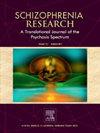临床精神病高危人群和健康对照者睡眠障碍与灰质体积之间的关系:一项纵向MRI研究(NAPLS-3)。
IF 3.5
2区 医学
Q1 PSYCHIATRY
引用次数: 0
摘要
目的:睡眠障碍和大脑改变在精神障碍和临床精神病高危人群中很常见。目前尚不清楚灰质体积的变化是精神病固有的还是部分由睡眠障碍引起的。这项研究调查了睡眠障碍是否会导致大脑结构的进行性变化。方法:数据来自北美前驱症状纵向研究(napl -3),包括507名chrp患者(平均年龄19岁,56.0%男性)和81名健康对照(HC)(平均年龄19岁,49.4%男性),在基线和前瞻性8个月时使用匹兹堡睡眠质量指数(PSQI)和3t结构MRI进行评估。通过基于全脑体素的形态测量分析评估睡眠和灰质体积之间的横断面关联。使用线性混合模型检验了持续性睡眠障碍与丘脑、海马体和小脑体积之间的纵向关联。结果:睡眠障碍在chrp患者中非常普遍(平均PSQI = 7.45),比HC患者更常见(p)。结论:我们的研究结果表明,chrp患者或HC患者的睡眠障碍与灰质体积之间没有关联。这一负面结果表明,睡眠问题虽然普遍存在并预示着精神病风险,但可能通过大脑结构变化以外的机制起作用,强调了它们作为早期干预目标的价值。本文章由计算机程序翻译,如有差异,请以英文原文为准。
Association between sleep disturbances and gray matter volume in individuals at clinical high-risk for psychosis and healthy controls: A longitudinal MRI study (NAPLS-3)
Objective
Sleep disturbances and brain alterations are common in psychotic disorders and individuals at clinical high risk for psychosis (CHR-P). It remains unclear whether gray matter volume changes are inherent to psychosis or partly driven by sleep disturbances. This study investigated whether sleep disturbances contribute to progressive structural brain changes.
Methods
Data were obtained from the North American Prodrome Longitudinal Study (NAPLS-3), including 507 CHR-P individuals (mean age 19; 56.0 % male) and 81 healthy controls (HC) (mean age 19; 49.4 % male), assessed with the Pittsburgh Sleep Quality Index (PSQI) and 3 T structural MRI at baseline and prospectively for 8 months. Cross-sectional associations between sleep and gray matter volume were assessed with whole-brain voxel-based morphometry analysis. Longitudinal associations between persistent sleep disturbances and thalamus, hippocampus, and cerebellum volume were examined using linear mixed models.
Results
Sleep disturbances were highly prevalent in CHR-P (mean PSQI = 7.45) and more common than in HC (p < .001). No significant cross-sectional or longitudinal associations were observed between sleep disturbances and gray matter volume in CHR-P nor HC. Exploratory analyses showed that higher PSQI scores were associated with increased odds of conversion to psychosis (OR = 1.059, p = .040).
Conclusions
Our findings indicate no association between sleep disturbances and gray matter volume in CHR-P individuals or HC. This negative result suggests that sleep problems, though prevalent and predictive of psychosis risk, likely act through mechanisms other than structural brain changes, underscoring their value as accessible targets for early intervention.
求助全文
通过发布文献求助,成功后即可免费获取论文全文。
去求助
来源期刊

Schizophrenia Research
医学-精神病学
CiteScore
7.50
自引率
8.90%
发文量
429
审稿时长
10.2 weeks
期刊介绍:
As official journal of the Schizophrenia International Research Society (SIRS) Schizophrenia Research is THE journal of choice for international researchers and clinicians to share their work with the global schizophrenia research community. More than 6000 institutes have online or print (or both) access to this journal - the largest specialist journal in the field, with the largest readership!
Schizophrenia Research''s time to first decision is as fast as 6 weeks and its publishing speed is as fast as 4 weeks until online publication (corrected proof/Article in Press) after acceptance and 14 weeks from acceptance until publication in a printed issue.
The journal publishes novel papers that really contribute to understanding the biology and treatment of schizophrenic disorders; Schizophrenia Research brings together biological, clinical and psychological research in order to stimulate the synthesis of findings from all disciplines involved in improving patient outcomes in schizophrenia.
 求助内容:
求助内容: 应助结果提醒方式:
应助结果提醒方式:


